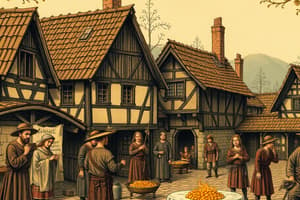Podcast
Questions and Answers
What was the primary difference between freemen and serfs during the Middle Ages?
What was the primary difference between freemen and serfs during the Middle Ages?
- Freemen were trained as knights, while serfs were farmers.
- Freemen had legal rights and could own land, while serfs were tied to the manor. (correct)
- Freemen were required to work on the noble's land, while serfs only worked their own.
- Freemen lived in castles, while serfs lived in villages.
Which of the following activities would NOT typically occur in a medieval peasant's late summer?
Which of the following activities would NOT typically occur in a medieval peasant's late summer?
- Harvesting grain.
- Slaughtering livestock.
- Planting crops like beans and peas. (correct)
- Salting meat for the winter.
What was the main function of the 'motte' in a medieval castle?
What was the main function of the 'motte' in a medieval castle?
- Serving as the open space for the castle.
- Functioning as a marketplace for the villagers.
- Providing a foundation for the castle's central building. (correct)
- Housing the stables and kitchens.
What was the primary responsibility of a noble's wife or daughter when the noble was away?
What was the primary responsibility of a noble's wife or daughter when the noble was away?
How could a serf gain freedom during the Middle Ages?
How could a serf gain freedom during the Middle Ages?
Besides working their own land, what additional obligations did serfs typically have?
Besides working their own land, what additional obligations did serfs typically have?
Which of these would typically be found on the ground floor of a medieval castle's keep?
Which of these would typically be found on the ground floor of a medieval castle's keep?
What was the purpose of the tournaments and jousting contests for medieval knights?
What was the purpose of the tournaments and jousting contests for medieval knights?
Flashcards
Freemen in the Middle Ages
Freemen in the Middle Ages
Peasants who owned their land and paid a noble for the right to farm it. They had legal rights and freedom to move and marry.
Serfs in the Middle Ages
Serfs in the Middle Ages
Peasants tied to a manor who couldn't own property, move, or marry without the noble's permission. They weren't slaves but had limited freedom.
Peasant Cottages
Peasant Cottages
A simple dwelling where peasants lived. Poorer peasants lived in single-room dwellings.
What is a Castle Keep?
What is a Castle Keep?
Signup and view all the flashcards
What is a Bailey?
What is a Bailey?
Signup and view all the flashcards
Medieval Tournaments
Medieval Tournaments
Signup and view all the flashcards
Knights in the Middle Ages
Knights in the Middle Ages
Signup and view all the flashcards
How could serfs gain freedom?
How could serfs gain freedom?
Signup and view all the flashcards
Study Notes
Feudalism and the Rise of Towns
- Feudalism was a new political and social order
- It arose after the fall of Charlemagne's empire when strong governments collapsed
- Kings, losing power, turned to local nobles for protection and order
- Nobles governed people and collected taxes in exchange for protection
- The nobility, both lords and vassals, shared loyalty and duty
- This system divided Europe's kingdoms into smaller territories centered on nobles' castles
- A system of oaths and service bound lords and vassals
- Vassals would receive land (a fief) in exchange for military service
- Knights, a type of vassal, were armored warriors who fought on horseback
- The invention of stirrups allowed for more effective mounted warfare
- Many knights followed the code of chivalry, emphasizing bravery, obedience to their lord, respect for noble women and the church, and helping others.
- The code of chivalry influenced modern ideas of good manners.
- Great powerful lords held more land than ordinary knights but shared a common purpose in defending their society
- During the Middle Ages, nobles were the most powerful group in Europe
Studying That Suits You
Use AI to generate personalized quizzes and flashcards to suit your learning preferences.




